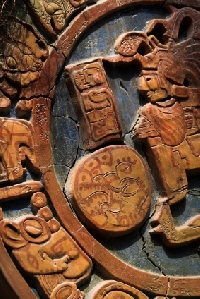
Diverse political themes and art movements give light to South American art.
Art in Latin America has many forms from the ancient Inca and Mayan sculptures to the modern Constructivist and Murilasimo art movements. The influence of European art in general, and Spanish, Portuguese and French artists in particular is apparent. Here are some representative samples of famous art of South America.
Pre-Columbian art in Bolivia
“Gate of the Sun” is a stone gateway constructed by the Tiwanaku culture 375 to 700 AD. It is located near Lake Titicaca in La Paz, Bolivia.
Mayan Art
Mayan art can be separated into paintings and sculpture. The stela were large stone slabs covered with carvings and was a common form of Maya sculpture. The stelae contained hieroglyphs which were used to determine the significance and history of Maya sites.
Paintings have also survived. The paintings “Bonarmpak” and “El Tajin Cacaxtla” represent the Maya Blue color, a dominant style of the use of color in the culture.
Modern Era ? The Constructivist Movement
The Constructive Movement originated in Russia dismissing ‘pure’ art in favor of art used for social purposes, specifically the construction of a socialist system. In Latin America, Joaqun Torres Garca of Uraguay used this form with his paintings “Arte Universal” and “Construction with Belltower.”
Manuel Rendn Seminario was another practitioner of the constructivist style. He was an Ecuadoran. One of his more famous works is “Tiza.”
Modern Era ? The Muralist Movement
The term ‘Muralist’ became famous with the Mexican Muralista art movement whose most important proponents were Diego Rivera, David Siqueriros and Jose Orozco. Diego Rivera is known for his “Detroit Industry,” “North Wall” and “South Wall.” Because his murals are on the side of buildings they have wide exposure to the surrounding audience.
~
David Siquerios is known for many murals of a revolutionary political bent. One of his largest is “The March of Humanity on Earth” and “Toward the Cosmos.” Other outside murals were “University to the People, The People the University” at the National Autonomous University of Mexico in Mexico City. And the massive 4,500-square-foot commission for Chapultepec Castle in Mexico City, “The Revolution Against the Porfirian Dicatorship” is a sight to behold.
Jose Orozco, like the previously mentioned muralists, was a socialist; the themes of his murals focused on human suffering. He was critical of the Mexican Revolution and his murals “The Elements,” “Man in Battle Against Nature,” and the “Destruction of the Old Order” depicted that skepticism.
Brazilian Art
Candido Portinari was a major proponent of the Neo-Realism style in painting. One of his best known paintings is “O lavrador de Caf?.” The painter Emiliano di Cavalcanti, who was a contemporary of Portinari’s, was also well known. His style was reminiscent of Picasso. One of his masterpieces is “O Nascimento de V?nus.”
Venezuelan Art
The artists of Venezuela were influenced by European styles. Martn Tovar y Tovar was one of the most important and high profile South American painters of the 19th century. His most famous work is his famous depiction of the “Battle of Carabobo.” Other famous paintings included “The Battle of Junin” and “The Battle of Ayacucho.”
In general, famous art of South America arose as the European focus began to fade in the early twentieth century. Through some of representative examples we’ve seen Latin Americans begin to acknowledge the uniqueness of their condition. Based on their own history and culture, they began to create their own artistic voice.

